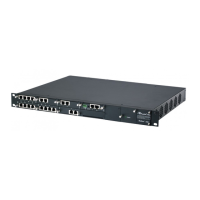SIP User's Manual 276 Document #: LTRT-83310
Mediant 600 & Mediant 1000
Parameter Description
Web/EMS: Source
Phone Prefix
Defines the prefix and/or suffix of the calling (source) telephone number. For
example, [100-199](100,101,105) denotes a number that starts with 100 to
199 and ends with 100, 101 or 105. For a description of notations that you
can use to represent single and multiple numbers (ranges), see 'Dialing Plan
Notation for Routing and Manipulation Tables' on page 787.
The number can include up to 50 digits.
Note: To denote any prefix, enter the asterisk (*) symbol.
All calls matching all or any combination of the above characteristics are sent to the IP destination
defined below.
Note: For alternative routing, additional entries of the same prefix can be configured.
Web: Dest. IP
Address
EMS: Address
Defines the IP address (in dotted-decimal notation or FQDN) to where the call
must be sent. If an FQDN is used (e.g., domain.com), DNS resolution is done
according to the DNSQueryType parameter.
Notes:
If you defined a destination IP Group (below), then this IP address is not
used for routing and therefore, not required.
To reject calls, enter 0.0.0.0. For example, if you want to prohibit
International calls, then in the 'Dest Phone Prefix' field, enter 00 and in the
'Dest IP Address' field, enter 0.0.0.0.
For routing calls between phones connected to the device (i.e., local
routing), enter the device's IP address.
When the device's IP address is unknown (e.g., when DHCP is used),
enter IP address 127.0.0.1.
When using domain names, you must enter the DNS server's IP address
or alternatively, define these names in the 'Internal DNS Table' (see
'Configuring the Internal DNS Table' on page 123).
If the string 'ENUM' is specified for the destination IP address, an ENUM
query containing the destination phone number is sent to the DNS server.
The ENUM reply includes a SIP URI used as the Request-URI in the
outgoing INVITE and for routing (if a proxy is not used).
The IP address can include the following wildcards:
"x": represents single digits. For example, 10.8.8.xx denotes all
addresses between 10.8.8.10 and 10.8.8.99.
"*": represents any number between 0 and 255. For example, 10.8.8.*
denotes all addresses between 10.8.8.0 and 10.8.8.255.
Web: Port
EMS: Destination
Port
Defines the destination port to where you want to route the call.
Web/EMS: Transport
Type
Defines the transport layer type for sending the IP call:
[-1] Not Configured
[0] UDP
[1] TCP
[2] TLS
Note: When set to Not Configured (-1), the transport type defined by the
SIPTransportType parameter is used.
Web: Dest IP Group
ID
EMS: Destination IP
Group ID
Defines the IP Group to where you want to route the call. The SIP INVITE
message is sent to the IP address defined for the Proxy Set ID associated
with the IP Group.
Notes:
If you select an IP Group, you do not need to configure a destination IP

